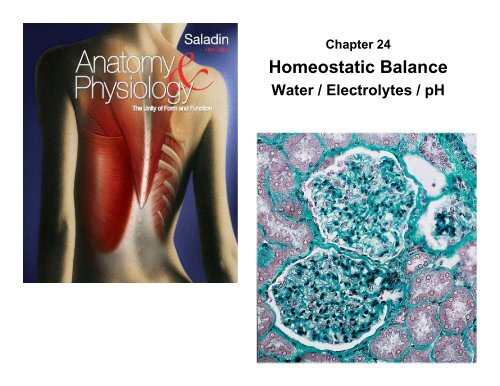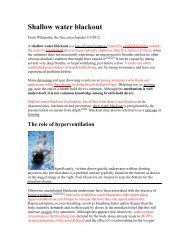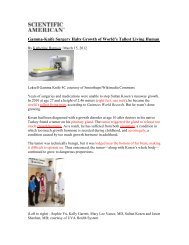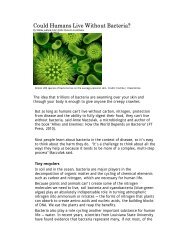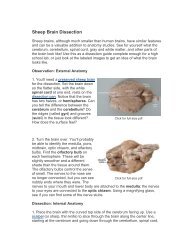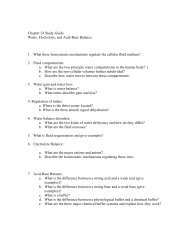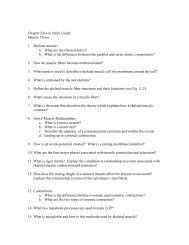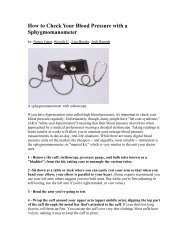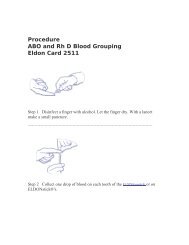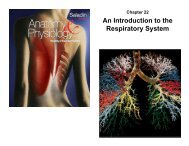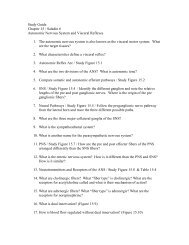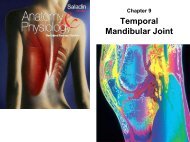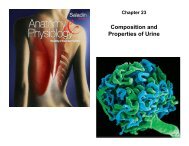Homeostatic Balance
Homeostatic Balance: Water / Electrolytes / pH
Homeostatic Balance: Water / Electrolytes / pH
- No tags were found...
You also want an ePaper? Increase the reach of your titles
YUMPU automatically turns print PDFs into web optimized ePapers that Google loves.
Chapter 24<br />
<strong>Homeostatic</strong> <strong>Balance</strong><br />
Water / Electrolytes / pH
Body Water<br />
• newborn baby’s body weight is about<br />
75% water<br />
• young men average 55% - 60%<br />
• women average slightly less<br />
• obese and elderly people as little as<br />
45% by weight<br />
• total body water (TBW) of a 70kg<br />
(150 lb) young make is about 40 liters
Fluid Compartments<br />
• major fluid compartments of the body<br />
– 65% intracellular fluid (ICF)<br />
– 35% extracellular fluid (ECF)<br />
• 25% tissue (interstitial) fluid<br />
• 8% blood plasma and lymphatic fluid (vascular)<br />
•2% transcellular fluid ‘catch-all’ category<br />
– cerebrospinal, synovial, peritoneal, pleural, and<br />
pericardial fluids<br />
– vitreous and aqueous humors of the eye<br />
– bile, and fluids of the digestive, urinary, and<br />
reproductive tracts
<strong>Balance</strong><br />
• cellular function requires a fluid medium with a carefully<br />
controlled composition<br />
• three “components” of fluid need to be controlled by<br />
homeostatic mechanisms<br />
– water balance<br />
• average daily water intake and loss are equal<br />
– electrolyte balance<br />
• the amount of electrolytes absorbed by the small intestine balance<br />
with the amount lost from the body, usually in urine<br />
– acid-base balance<br />
• the body rids itself of acid (hydrogen ion – H + ) at a rate that<br />
balances metabolic production<br />
• These “balances” are maintained by the collective action of<br />
the urinary, respiratory, digestive, integumentary, endocrine,<br />
nervous, cardiovascular, and lymphatic systems
Water Movement Between Fluid Compartments<br />
• fluid continually exchanged between compartments<br />
• water moves across membranes by osmosis<br />
• because water moves easily through plasma membranes,<br />
osmotic gradients never last for very long<br />
• if imbalance arises, osmosis restores balance within<br />
seconds so the intracellular and extracellular osmolarity<br />
are equal<br />
– if osmolarity of the tissue fluid rises, water moves out of the<br />
cell<br />
– if it falls, water moves in<br />
• osmosis from one fluid compartment to another is<br />
determined by the relative concentrations of solutes in<br />
each compartment<br />
– electrolytes – the most abundant solute particles, by far<br />
– sodium salts in ECF<br />
– potassium salts in ICF<br />
• electrolytes play the principal role in governing the body’s<br />
water distribution and total water content
Water Movement Between Fluid Compartments<br />
Intracellular<br />
fluid<br />
Digestive tract<br />
Bloodstream<br />
Tissue fluid<br />
Lymph<br />
Bloodstream
Water <strong>Balance</strong> & Gain<br />
• fluid balance - when daily gains and losses<br />
are equal (about 2,500 mL/day)<br />
• gains come from two sources:<br />
– preformed water (2,300 mL/day)<br />
• ingested in food (700 mL/day)<br />
• drink (1600 mL/day)<br />
– metabolic water (200 mL/day)<br />
• by-product of aerobic metabolism and dehydration<br />
synthesis<br />
–C 6<br />
H 12<br />
O 6<br />
+ 6O 2<br />
6CO 2<br />
+ 6H 2<br />
O
Water Loss<br />
• sensible water loss is observable<br />
– 1,500 mL/ day is in urine<br />
– 200 mL/day is in feces<br />
– 100 mL/day is sweat in resting adult<br />
• insensible water loss is unnoticed<br />
– 300 mL/day in expired breath<br />
– 400 mL/day is cutaneous transpiration<br />
• diffuses through epidermis and evaporates<br />
– does not come from sweat glands<br />
– loss varies greatly with environment and activity<br />
• obligatory water loss is output that is<br />
relatively unavoidable<br />
• expired air, cutaneous transpiration, sweat, fecal<br />
moisture, and urine output
Fluid <strong>Balance</strong><br />
Copyright © The McGraw-Hill Companies, Inc. Permission required for reproduction or display.<br />
Intake<br />
2,500 mL/day<br />
Output<br />
2,500 mL/day<br />
Metabolic water<br />
200 mL<br />
Food<br />
700 mL<br />
Feces<br />
200 mL<br />
Expired air<br />
300 mL<br />
Cutaneous<br />
transpiration<br />
400 mL<br />
Sweat 100 mL<br />
Drink<br />
1,600 mL<br />
Urine<br />
1,500 mL
Regulation of Fluid Intake<br />
• Thirst is the “sense” that governs fluid intake<br />
– dehydration results in<br />
• increase blood osmolarity<br />
• low blood volume “linked to” low blood pressure<br />
– osmoreceptors in hypothalamus sense increase in osmolarity<br />
• osmoreceptors communicate with the hypothalamus and cerebral cortex<br />
• hypothalamus produces antidiuretic hormone<br />
• promotes water conservation<br />
– tissue in kidneys sense reduced blood pressure<br />
• activates renin - angiotensin mechanism<br />
• BP drops (concurrent rise in osmolarity of ECF) with a drop in blood volume<br />
– salivation is inhibited with thirst<br />
• sympathetic signals from thirst center to salivary glands<br />
– cerebral cortex produces conscious sense of thirst<br />
• Mediated by Angiotensin and ADH<br />
• intense sense of thirst with 2-3% increase in plasma osmolarity<br />
• 10-15% blood loss
Dehydration, Thirst, and<br />
Rehydration
Thirst Satiation Mechanisms<br />
• long term inhibition of thirst<br />
– absorption of water from small intestine<br />
– reduces osmolarity of blood<br />
• stops the osmoreceptor response<br />
• promotes capillary filtration<br />
• makes the saliva more abundant and watery<br />
• changes require 30 minutes or longer to take effect<br />
• short term inhibition of thirst<br />
– cooling and moistening of mouth quenches thirst<br />
– distension of stomach and small intestine<br />
– 30 to 45 min of satisfaction<br />
• must be followed by water being absorbed into the<br />
bloodstream or thirst returns<br />
– short term response designed to prevent overdrinking
Regulation of Water Output<br />
• only way to control water output in a significant way is through<br />
variation in urine volume<br />
– kidneys can’t replace water or electrolytes<br />
– only slow rate of water and electrolyte loss until water and<br />
electrolytes can be ingested<br />
• Two mechanisms regulated by hormones:<br />
– Aldosterone hormone<br />
• changes in urine volume linked to adjustments in Na + reabsorption<br />
• as Na + is reabsorbed water follows<br />
– Anitdiuretic hormone<br />
• concentrate the urine<br />
• ADH secretion stimulated by hypothalamic osmoreceptors in response to<br />
dehydration<br />
• aquaporins synthesized in response to ADH<br />
– membrane proteins in renal collecting ducts whose job is to channel water back<br />
into renal medulla, Na + is still excreted<br />
– slows decrease in water volume and increased osmolarity – concentrates urine<br />
• ADH release inhibited when blood volume and pressure is too high or<br />
blood osmolarity too low<br />
– effective way to compensate for hypertension
Secretion<br />
and<br />
Effects of<br />
ADH
Disorders of Water <strong>Balance</strong><br />
• state of fluid imbalance - if there is an abnormality of total volume,<br />
concentration, or distribution of fluid among the compartments<br />
– fluid deficiency – results from fluid output exceeds intake over long<br />
period of time<br />
• volume depletion (hypovolemia)<br />
– occurs when proportionate amounts of water and sodium are lost without<br />
replacement<br />
– total body water declines<br />
– osmolarity remains normal<br />
– hemorrhage, severe burns, chronic vomiting, or diarrhea<br />
• dehydration (negative water balance)<br />
– body eliminates significantly more water than sodium<br />
– total body water declines<br />
– osmolarity rises<br />
– lack of drinking water, diabetes, ADH hyposecretion (diabetes insipidus),<br />
profuse sweating, overuse of diuretics<br />
– infants more vulnerable to dehydration than adults due to high metabolic rate<br />
that demands high urine excretion, immature kidneys cannot<br />
concentrate urine effectively, greater ratio of body surface to mass<br />
– affects all fluid compartments (ICF, blood, and tissue fluid)<br />
– most serious effects:<br />
• circulatory shock due to loss of blood volume, neurological dysfunction<br />
due to dehydration of brain cells, infant mortality from diarrhea
Fluid Excess<br />
• less common than fluid deficiency<br />
• kidneys are highly effective in compensating for excessive<br />
intake by excreting more urine<br />
• exception = renal failure which can lead to fluid retention<br />
• two types of fluid excesses<br />
– volume excess (hypervolumeia)<br />
• both Na + and water retained<br />
• ECF remains isotonic<br />
• caused by aldosterone hypersecretion or renal failure<br />
– hypotonic hydration<br />
• water intoxication (positive water balance)<br />
• more water than Na + retained or ingested<br />
• ECF becomes hypotonic<br />
– can cause cellular swelling<br />
– pulmonary and cerebral edema
Blood Volume and Fluid Intake<br />
Copyright © The McGraw-Hill Companies, Inc. Permission required for reproduction or display.<br />
5<br />
Blood volume (L)<br />
4<br />
3<br />
2<br />
1<br />
Hypovolemia<br />
Death<br />
Danger Normal<br />
Water diuresis<br />
0<br />
0<br />
1 2 3 4 5 6 7 8<br />
Fluid intake (L/day)<br />
kidneys compensate very well for excessive fluid<br />
intake, but not for inadequate fluid intake
Fluid Sequestration<br />
• a condition in which excess fluid accumulates in<br />
a particular location<br />
– Example: total body water may be normal, but<br />
volume of circulating blood may drop to a point<br />
causing circulatory shock<br />
• most common forms:<br />
– edema - abnormal accumulation of fluid in the<br />
interstitial spaces, causing swelling of the tissues<br />
– hemorrhage - another cause of fluid<br />
sequestration<br />
• blood that pools in the tissues is lost to circulation<br />
– pleural effusion – several liters of fluid can<br />
accumulate in the pleural cavity<br />
• caused by some lung infections
Fluid <strong>Balance</strong> in Cold Weather<br />
• Body conserves heat by constricting blood vessels in the skin<br />
– Net result = blood shifted to “core” circulation<br />
– May cause one or more of the following:<br />
• raises blood pressure<br />
• inhibits secretion of ADH<br />
• increases secretion of atrial natriuretic peptide<br />
• Increase urine production (stored in bladder)<br />
• blood volume reduced<br />
• exercise dilates vessels in skeletal muscles / more blood in muscle less in systemic<br />
circulation<br />
• insufficient blood for rest of the body can bring on weakness, fatigue, or fainting<br />
(hypovolemic shock)<br />
– Complicating factor<br />
• Winter’s cold air is drier<br />
• With exercise there is an increased respiration<br />
• water loss via expired gasses also reducing blood volume<br />
• cold weather plus volume loss from respiratory and urinary systems cause<br />
a state of reduced blood volume (hypovolemia)<br />
• This explains why there is a high incident of heart attacks when<br />
people shovel snow in the winter!
Dehydration from Excessive Sweating<br />
Copyright © The McGraw-Hill Companies, Inc. Permission required for reproduction or display.<br />
H 2 O<br />
H 2 O<br />
1<br />
Water loss<br />
(sweating)<br />
H 2 O<br />
2 Sweat glands<br />
produce perspiration<br />
by capillary<br />
filtration.<br />
Secretory cells<br />
of sweat gland<br />
H 2 O<br />
H 2 O<br />
3 Blood volume 4<br />
and pressure drop;<br />
osmolarity rises.<br />
5<br />
H 2 O<br />
Skin<br />
Sweat pores<br />
Sweat gland<br />
Intracellular fluid<br />
diffuses out of<br />
cells to replace<br />
lost tissue fluid.<br />
H 2 O<br />
Blood absorbs tissue<br />
fluid to replace loss.<br />
1) water loss from sweating<br />
2) sweat produced by<br />
capillary filtration<br />
3) blood volume and<br />
pressure drop, osmolarity<br />
rises<br />
4) blood absorbs tissue fluid<br />
to replace loss<br />
5) tissue fluid pulled from ICF<br />
6) all three compartments<br />
lose water<br />
7) 300 mL from tissue fluid<br />
and 700 mL from ICF
Electrolyte <strong>Balance</strong><br />
• physiological functions of electrolytes<br />
– chemically reactive and participate in metabolism<br />
– determine electrical potential (charge difference)<br />
across cell membranes<br />
– strongly affect osmolarity of body fluids<br />
– affect body’s water content and distribution<br />
• major cations<br />
– Na + , K + , Ca 2+ , and H +<br />
• major anions<br />
– Cl - , HCO 3-<br />
(bicarbonate), and PO 4<br />
3-<br />
• great differences between electrolyte<br />
concentrations of blood plasma and intracellular<br />
fluid (ICF)<br />
– But they have the same osmolarity (300 mOsm/L)<br />
• concentrations in tissue fluid (ECF) differ only<br />
slightly from those in the plasma
Electrolyte Concentrations<br />
145<br />
103<br />
300<br />
4<br />
5 4<br />
(a) Blood plasma<br />
150<br />
300<br />
75<br />
12<br />
4 < 1<br />
Na + K + Cl – Ca 2+ P i<br />
(mEq/L)<br />
(b) Intracellular fluid<br />
Osmolarity<br />
(mOsm/L)
Sodium - Functions<br />
• sodium - principal ions responsible for the resting<br />
membrane potentials<br />
– inflow of sodium through membrane gates is an<br />
essential event in the depolarization that underlies<br />
nerve and muscle function<br />
• Sodium is principal cation in ECF<br />
– sodium salts accounts for 90 - 95% of osmolarity of<br />
ECF<br />
– most significant solute in determining total body water<br />
and distribution of water among the fluid compartments<br />
• Na + gradient a source of potential energy for<br />
cotransport of other solutes such as glucose,<br />
potassium, and calcium<br />
• Na + -K + pump<br />
– exchanges intracellular Na + for extracellular K +<br />
– generates body heat<br />
• NaHCO 3 has major role in buffering pH in ECF
Sodium - Homeostasis<br />
• adult needs about 0.5 g of sodium per day<br />
– typical American diet contains 3 – 7 g/day<br />
• primary concern - excretion of excess dietary sodium<br />
• sodium concentration coordinated by:<br />
– aldosterone - “salt retaining hormone”<br />
• primary role in limiting sodium excretion<br />
• hyponatremia and hyperkalemia directly stimulate the adrenal cortex to<br />
secrete aldosterone<br />
• hypotension stimulates aldosterone secretion by way of the reninangiotensin-aldosterone<br />
mechanism<br />
• aldosterone receptors in ascending limb of nephron loop, the distal<br />
convoluted tubule, and cortical part of collecting duct<br />
• aldosterone, a steroid, binds to nuclear receptors<br />
– activates transcription of a gene for the Na + -K + pumps<br />
– in 10 – 30 minutes enough Na + -K + pumps are inserted in the plasma<br />
membrane to make a noticeable effect<br />
– tubules reabsorb more sodium and secrete more hydrogen and potassium<br />
– water and chloride passively follow sodium<br />
• primary effects of aldosterone<br />
– less NaCl in urine<br />
– more potassium urine<br />
– more protons (more acidic) in urine
Sodium - Homeostasis<br />
– elevated blood pressure inhibits the renin-angiotensin-aldosterone<br />
mechanism<br />
– kidneys reabsorb almost no sodium<br />
– urine contains up to 30 g of sodium per day instead of normal 5 g<br />
– ADH<br />
• modifies water excretion independently of sodium excretion<br />
• high sodium concentration in the blood stimulate the posterior lobe of the<br />
pituitary to release ADH<br />
• kidneys reabsorbs more water<br />
• slows down any further increase in blood sodium concentration<br />
• drop in sodium inhibits ADH release<br />
• more water is excreted, raising the sodium level in the blood<br />
– ANP (atrial natriuretic peptide) and BNP (brain natriuretic peptide )<br />
• inhibit sodium and water reabsorption, and the secretion of renin and ADH<br />
• kidneys eliminate more sodium and water lowering blood pressure<br />
– Others hormones affecting hydration:<br />
• estrogen mimics aldosterone and women retain water during pregnancy<br />
• progesterone reduces sodium reabsorption and has a diuretic effect<br />
• sodium homeostasis is achieved by regulating salt intake<br />
– salt cravings in humans and other animals
Sodium - Imbalances<br />
• hypernatremia<br />
– plasma sodium concentration greater<br />
than 145 mEq/L<br />
• from administration of IV saline<br />
• water pretension, hypertension and<br />
edema<br />
• hyponatremia<br />
– plasma sodium concentration less<br />
than 130 mEq/L<br />
• person loses large volumes of sweat<br />
or urine, replacing it with drinking plain<br />
water<br />
• result of excess body water, quickly<br />
corrected by excretion of excess water
Potassium - Functions<br />
• most abundant cation of ICF<br />
• greatest determinant of intracellular<br />
osmolarity and cell volume<br />
• produces (with sodium) the resting<br />
membrane potentials and action<br />
potentials of nerve and muscle cells<br />
• Na + -K + pump<br />
– co-transport and thermogenesis<br />
• essential cofactor for protein<br />
synthesis and other metabolic<br />
processes
Potassium - Homeostasis<br />
• potassium homeostasis is closely linked to<br />
sodium<br />
• 90% of K + in glomerular filtrate is<br />
reabsorbed by the PCT<br />
– rest excreted in urine<br />
• DCT and cortical portion of collecting duct<br />
secrete K + in response to blood levels<br />
• Aldosterone stimulates renal secretion of K +<br />
– Antiport / Sodium reabsorbed and potasium<br />
excreted
Secretion and Effects of Aldosterone<br />
Hypotension<br />
H 2 O<br />
Hyponatremia Hyperkalemia<br />
Na + K +<br />
K +<br />
Renin<br />
Angiotensin<br />
Stimulates<br />
adrenal cortex<br />
to secrete<br />
aldosterone<br />
Negative<br />
feedback<br />
loop<br />
Stimulates renal<br />
tubules<br />
Increases Na +<br />
reabsorption<br />
Increases K +<br />
secretion<br />
Less Na +<br />
and H 2 O in urine<br />
More K +<br />
in urine<br />
Supports existing<br />
fluid volume and<br />
Na + concentration<br />
pending oral intake
Potassium - Imbalances<br />
• This is potentially the most dangerous imbalance of any electrolyte.<br />
• hyperkalemia<br />
– greater than 5.5 mEq/L<br />
– effects depend on whether the potassium concentration rises quickly or<br />
slowly<br />
– concentration rises quickly, (crush injury)<br />
• sudden increase in extracellular K +<br />
• nerve and muscle cells abnormally excitable<br />
– concentration rises slowly<br />
• inactivates voltage-regulated Na + channels (can not initiate action<br />
potential)<br />
• nerve and muscle cells become less excitable<br />
• can produce cardiac arrest<br />
• hypokalemia<br />
– less than 3.5 mEq/L<br />
– rarely results from dietary deficiency<br />
– from sweating, chronic vomiting or diarrhea<br />
– nerve and muscle cells less excitable<br />
• muscle weakness, loss of muscle tone, decreased reflexes, and<br />
arrhythmias from irregular electrical activity in the heart
Potassium & Membrane Potentials<br />
mV<br />
+<br />
–<br />
Elevated extracellular<br />
K + concentration<br />
Less diffusion of K +<br />
out of cell<br />
K +<br />
mV<br />
+<br />
–<br />
RMP<br />
Elevated RMP (cells<br />
partially depolarized)<br />
Cells more excitable<br />
K + concentrations<br />
in equilibrium<br />
Equal diffusion into<br />
and out of cell<br />
Normal resting<br />
membrane<br />
potential (RMP)<br />
Hyperkalemia<br />
+<br />
mV<br />
–<br />
(a) Normokalemia<br />
Reduced extracellular<br />
K + concentration<br />
Greater diffusion of<br />
K + out of cell<br />
Reduced RMP (cells<br />
hyperpolarized)<br />
Cells less excitable<br />
Hypokalemia
Chloride - Functions<br />
• most abundant anions in ECF<br />
– major contribution to ECF osmolarity<br />
• required for the formation of stomach<br />
acid<br />
– hydrochloric acid (HCl)<br />
• chloride shift that accompanies CO 2<br />
loading and unloading in RBCs<br />
• major role in regulating body pH
Chloride - Homeostasis<br />
• strong attraction to Na + , K +<br />
and Ca 2+ , which chloride<br />
passively follows<br />
• primary homeostasis<br />
achieved as an effect of Na +<br />
homeostasis<br />
– as sodium is retained<br />
– chloride ions passively follow
Chloride - Imbalances<br />
• hyperchloremia<br />
– result of dietary excess or<br />
administration of IV saline<br />
• hypochloremia<br />
– side effect of hyponatremia<br />
– sometimes from hyperkalemia or<br />
acidosis<br />
• primary effects:<br />
– disturbances in acid-base balance
Calcium - Functions<br />
• lends strength to the skeleton<br />
• activates sliding filament<br />
mechanism of muscle contraction<br />
• serves as a second messenger for<br />
some hormones and<br />
neurotransmitters<br />
• activates exocytosis of<br />
neurotransmitters and other<br />
cellular secretions<br />
• essential factor in blood clotting
Calcium - Homeostasis<br />
• calcium homeostasis is chiefly regulated by<br />
– parathyroid hormone (PTH)<br />
– calcitriol (vitamin D)<br />
– calcitonin (in children)<br />
• these hormones affect bone deposition and resorption<br />
• intestinal absorption and urinary excretion<br />
• cells maintain very low intracellular Ca 2+ levels<br />
– to prevent calcium phosphate crystal precipitation<br />
• phosphate levels are high in the ICF<br />
– cells must pump Ca 2+ out<br />
– keeps intracellular concentration low<br />
– or sequester Ca 2+ in smooth ER and release it when<br />
needed<br />
– calsequestrin – proteins that bind Ca 2+ and keep it<br />
unreactive in Ca 2+ storage cells
Calcium - Imbalances<br />
• hypercalcemia – greater than 5.8 mEq/L<br />
– alkalosis, hyperparathyroidism, hypothyroidism<br />
– reduces membrane Na + permeability, inhibits<br />
depolarization of nerve and muscle cells<br />
– concentrations greater than 12 mEq/L causes<br />
muscular weakness, depressed reflexes,<br />
cardiac arrhythmias<br />
• hypocalcemia – less than 4.5 mEq/L<br />
– vitamin D deficiency, diarrhea, pregnancy,<br />
acidosis, lactation, hypoparathyroidism,<br />
hyperthyroidism<br />
– increases membrane Na + permeability<br />
• nervous and muscular systems become<br />
abnormally excitable<br />
– very low levels result in tetanus, laryngospasm,<br />
death
Phosphates - Functions<br />
• relatively concentrated in ICF due to<br />
hydrolysis of ATP and other phosphate<br />
compounds<br />
• inorganic phosphates (P i ) of the body fluids are<br />
an equilibrium mixture of phosphate (PO 4<br />
3-<br />
),<br />
monohydrogen phosphate (HPO 4<br />
2-<br />
), and<br />
dihydrogen phosphate (H 2 PO 4- )<br />
• components of:<br />
– nucleic acids, phospholipids, ATP, GTP, cAMP,<br />
and creatine phosphate<br />
• activates many metabolic pathways by<br />
phosphorylating enzymes and substrates such<br />
as glucose<br />
• Phosphates may act as a buffer to help stabilize<br />
the pH of body fluids
Phosphates - Homeostasis<br />
• renal control<br />
– normally phosphate is continually lost by glomerular<br />
filtration<br />
– if plasma concentration drops, renal tubules<br />
reabsorb all filtered phosphate<br />
• parathyroid hormone<br />
– increases excretion of phosphate which increases<br />
concentration of free calcium in the ECF<br />
– lowering the ECF concentration of phosphate<br />
minimizes the formation of calcium phosphate and<br />
helps support plasma calcium concentration<br />
• imbalances not as critical<br />
– body can tolerate broad variations in concentration<br />
of phosphate
Acid-Base <strong>Balance</strong><br />
• one of the most important aspects of homeostasis<br />
– metabolism depends on enzymes, and enzymes are<br />
sensitive to pH<br />
– slight deviation from the normal pH can shut down<br />
entire metabolic pathways<br />
– slight deviation from normal pH can alter the structure<br />
and function of macromolecules<br />
• 7.35 to 7.45 is the normal pH range of blood and<br />
tissue fluid<br />
• challenges to acid-base balance:<br />
– metabolism constantly produces acid<br />
• lactic acids from anaerobic fermentation<br />
• phosphoric acid from nucleic acid catabolism<br />
• fatty acids and ketones from fat catabolism<br />
• carbonic acid from carbon dioxide
Acids and Bases<br />
• pH of a solution is determined solely by its<br />
hydrogen ions (H + )<br />
• acids – any chemical that releases H + in solution<br />
– strong acids like hydrochloric acid (HCl) ionize freely<br />
• gives up most of its H +<br />
• markedly lower pH of a solution<br />
– weak acids like carbonic acid (H 2<br />
CO 3<br />
) ionize only<br />
slightly<br />
• keeps most H + chemically bound<br />
• does not affect pH<br />
• bases – any chemical that accepts H +<br />
– strong bases, like the hydroxide ion (OH - ), has a<br />
strong tendency to bind H + , markedly raising pH<br />
– weak bases, such as the bicarbonate ion (HCO 3- )<br />
bind less available H + and has less effect on pH
Acid-Base <strong>Balance</strong><br />
pH<br />
Normal<br />
7.45<br />
7.35<br />
Alkalosis<br />
Acidosis<br />
8.0<br />
6.8<br />
Death<br />
Death<br />
H 2 CO 3 HCO 3<br />
–
Buffers<br />
• buffer – any mechanism that resists changes in pH<br />
– convert strong acids or bases to weak ones<br />
• physiological buffer - system that controls output of acids,<br />
bases, or CO 2<br />
– urinary system buffers greatest quantity of acid or base<br />
• takes several hours to days to exert its effect<br />
– respiratory system buffers within minutes<br />
• cannot alter pH as much as the urinary system<br />
• chemical buffer – a substance that binds H + and removes it from<br />
solution as its concentration begins to rise, or releases H + into<br />
solution as its concentration falls<br />
– restore normal pH in fractions of a second<br />
– function as mixtures called buffer systems composed of weak acids<br />
and weak bases<br />
– three major chemical buffers : bicarbonate, phosphate, and<br />
protein systems<br />
• amount of acid or base neutralized depends on the concentration of the buffers and<br />
the pH of the working environment
Bicarbonate Buffer System<br />
• bicarbonate buffer system – a solution of<br />
carbonic acid and bicarbonate ions.<br />
• carbonic acid and bicarbonate ions<br />
– CO 2<br />
+ H 2<br />
O ↔ H 2<br />
CO 3<br />
↔ HCO 3-<br />
+ H +<br />
• reversible reaction important in ECF<br />
– CO 2<br />
+ H 2<br />
O → H 2<br />
CO 3<br />
→ HCO 3-<br />
+ H +<br />
• lowers pH by releasing H +<br />
– CO 2<br />
+ H 2<br />
O ← H 2<br />
CO 3<br />
← HCO 3-<br />
+ H +<br />
• raises pH by binding H +<br />
• functions best in the lungs and kidneys to<br />
constantly remove CO 2<br />
– to lower pH, kidneys excrete HCO 3<br />
-<br />
– to raise pH, kidneys excrete H + and lungs excrete<br />
CO 2
Phosphate Buffer System<br />
• a solution of HPO 4<br />
2-<br />
and H 2 PO 4<br />
-<br />
• H 2 PO 4- ↔ HPO 4<br />
2-<br />
+ H +<br />
– as in the bicarbonate system, reactions<br />
that proceed to the right liberating H + and<br />
decreasing pH, and those to the left<br />
increase pH<br />
• more important buffering the ICF and<br />
renal tubules<br />
– where phosphates are more<br />
concentrated and function closer to their<br />
optimum pH of 6.8<br />
• constant production of metabolic acids creates<br />
pH values from 4.5 to 7.4 in the ICF, avg. 7.0
Protein Buffer System<br />
• proteins are more concentrated than<br />
bicarbonate or phosphate systems,<br />
especially in the ICF<br />
• protein buffer system accounts for<br />
about three-quarters of all chemical<br />
buffering in the body fluids<br />
• protein buffering ability is due to certain<br />
side groups of their amino acid residues<br />
• carboxyl (-COOH) side groups which<br />
releases H + when pH begins to rise<br />
• others have amino (-NH 2 ) side groups<br />
that bind H + when pH gets too low
Respiratory Control of pH<br />
• basis for the strong buffering capacity of the respiratory<br />
system<br />
– the addition of CO 2<br />
to the body fluids raises the H +<br />
concentration and lowers pH<br />
– the removal of CO 2<br />
has the opposite effects<br />
• neutralizes 2 to 3 times as much acid as chemical buffers<br />
• CO 2 is constantly produced by aerobic metabolism<br />
– normally eliminated by the lungs at an equivalent rate<br />
– CO 2<br />
+ H 2<br />
O → H 2<br />
CO 3<br />
→ HCO 3-<br />
+ H +<br />
• lowers pH by releasing H +<br />
– CO 2 (expired) + H 2 O ← H 2 CO 3<br />
← HCO 3-<br />
+ H +<br />
• raises pH by binding H +<br />
• increased CO 2 and a decrease in the pH number (i.e.<br />
more acidic) stimulate pulmonary ventilation<br />
• Decreased C02 and an increase in the pH number (i.e.<br />
more alkaline or basic) inhibits pulmonary ventilation
Renal Control of pH<br />
• the kidneys can neutralize more acid<br />
or base than either the respiratory<br />
system or chemical buffers<br />
• renal tubules secrete H + into the<br />
tubular fluid<br />
– most binds to bicarbonate, ammonia, and<br />
phosphate buffers<br />
– bound and free H + are excreted in the urine<br />
– Kidney actually expelling H + from the body,<br />
not just “binding it to another molecule<br />
– other buffer systems only reduce its<br />
concentration by binding it to other<br />
chemicals
H + Secretion and Excretion in Kidney<br />
Copyright © The McGraw-Hill Companies, Inc. Permission required for reproduction or display.<br />
1 H + in blood reacts with HCO 3<br />
– to<br />
form H 2 CO 3 .<br />
Blood of<br />
peritubular capillary<br />
Renal tubule cells<br />
(proximal convoluted tubule)<br />
Tubular fluid<br />
2 H2 CO 3 decomposes into H 2 O and<br />
CO 2 , which enter the tubule cell.<br />
Glomerular<br />
filtrate<br />
3<br />
Tubule cells acquire CO 2 from<br />
blood, tubular fluid, and their own<br />
aerobic respiration.<br />
4 Carbonic anhydrase (CAH) combines<br />
H 2 O and CO 2 to re-form H 2 CO 3 .<br />
5 H 2 CO 3 ionizes to form HCO 3<br />
– (which<br />
returns to the blood) and H + .<br />
6 Na + –H + antiport exchanges H + for Na + .<br />
+ 7<br />
K +<br />
8<br />
NaHCO 3<br />
6<br />
Na + Na +<br />
Na<br />
HCO 3<br />
–<br />
HCO 3<br />
–+ H +<br />
H +<br />
HCO 3<br />
–<br />
H +<br />
5<br />
1<br />
9<br />
H 2 CO 3<br />
H 2 CO 3<br />
4 CAH<br />
10 CAH<br />
7 NaHCO 3 from glomerular filtrate<br />
decomposes into Na + and HCO 3<br />
–.<br />
Na + is pumped into tubule cell.<br />
2<br />
H 2 O<br />
H 2 O<br />
3<br />
H 2 O<br />
+<br />
CO 2<br />
CO 2<br />
CO 2<br />
8 Na + is removed by Na + –K +<br />
pump at the base of the cell.<br />
11<br />
Urine<br />
9 HCO 3<br />
– reacts with H + from tubule<br />
cell to form H 2 CO 3 .<br />
Key<br />
10 CAH on brush border decomposes<br />
H 2 CO 3 11111to H 2 O and CO 2 again.<br />
Aerobic respiration<br />
Antiport<br />
Diffusion through a<br />
membrane channel<br />
11<br />
CO 2 enters the tubular cell and H 2 O passes in the<br />
urine (carrying the H + that was originally in the blood).<br />
Diffusion through the<br />
membrane lipid
Limiting pH<br />
• tubular secretion of H + (step 6)<br />
– continues only with a steep concentration gradient of<br />
H + between tubule cells and tubular fluid<br />
– if H + concentration increased in tubular fluid, lowering<br />
pH to 4.5, secretion of H + stops – limiting pH<br />
• this is prevented by buffers in tubular fluid<br />
– bicarbonate system – all bicarbonate ions in tubular<br />
fluid are consumed neutralizing H +<br />
• so there is no HCO 3- in the urine<br />
• the more acid the kidneys secrete, less sodium is in the<br />
urine<br />
– phosphate system - dibasic sodium phosphate is<br />
contained in glomerular filtrate<br />
• reacts with some of the H + replacing a Na + in the buffer<br />
which passes into the urine<br />
• Na 2 HPO 4 + H + → NaH 2 PO 4 + Na +<br />
– ammonia (NH 3<br />
) - from amino acid catabolism acts as<br />
a base to neutralize acid<br />
• NH 3 + H + and Cl - → NH 4 Cl (ammonium chloride – a weak acid)
Buffering Mechanisms in Urine<br />
Blood of<br />
peritubular<br />
capillary<br />
Copyright © The McGraw-Hill Companies, Inc. Permission required for reproduction or display.<br />
Renal tubule cells<br />
(proximal convoluted tubule)<br />
Tubular fluid<br />
HCO 3<br />
–<br />
H 2<br />
CO 3<br />
HCO – 3<br />
+<br />
H +<br />
H + + Na 2<br />
HPO 4<br />
Glomerular filtrate<br />
Na +<br />
K + Na + +NaH 2<br />
PO 4<br />
Amino acid<br />
catabolism<br />
NH 3<br />
HCO – 3 +<br />
H +<br />
H 2<br />
CO 3<br />
Na +<br />
H + + NH 3<br />
+Cl –<br />
NH 4<br />
Cl<br />
Urine<br />
Key<br />
Antiport<br />
Diffusion through a<br />
membrane channel<br />
Diffusion through the<br />
membrane lipid
Disorders of Acid-Base <strong>Balance</strong> / Acidosis<br />
• In acidosis<br />
– pH below 7.35<br />
– H + diffuses into cells and drives out K + , elevating K +<br />
concentration in ECF<br />
• H + buffered by protein in ICF<br />
• causes membrane hyperpolarization<br />
• nerve and muscle cells are hard to stimulate<br />
• CNS depression may lead to confusion, disorientation,<br />
coma, and possibly death<br />
See Next Slide
Disorders of Acid-Base <strong>Balance</strong> / Alkalosis<br />
• In alkalosis<br />
– pH above 7.45<br />
– H + diffuses out of cells<br />
– K + diffuses in<br />
– membranes depolarized, nerves overstimulated,<br />
muscles causing spasms, tetany, convulsions,<br />
respiratory paralysis<br />
– a person cannot live for more than a few hours if the<br />
blood pH is below 7.0 or above 7.7<br />
See Next Slide
Disorders of Acid-Base <strong>Balance</strong>s<br />
• acid-base imbalances fall into one of<br />
two categories:<br />
– Respiratory<br />
– Metabolic<br />
• respiratory acidosis<br />
– occurs when rate of alveolar ventilation<br />
fails to keep pace with the body’s rate of<br />
CO 2 production<br />
– carbon dioxide accumulates in the ECF<br />
and lowers its pH<br />
– occurs in emphysema where there is a<br />
severe reduction of functional alveoli<br />
• respiratory alkalosis<br />
– results from hyperventilation<br />
– CO 2 eliminated faster than it is produced
Disorders of Acid-Base <strong>Balance</strong>s<br />
• metabolic acidosis<br />
– increased production of organic acids<br />
such as lactic acid in anaerobic<br />
fermentation, and ketone bodies seen<br />
in alcoholism, and diabetes mellitus<br />
– ingestion of acidic drugs (aspirin)<br />
– loss of base due to chronic diarrhea,<br />
laxative overuse<br />
• metabolic alkalosis<br />
– rare, but can result from:<br />
– overuse of bicarbonates (antacids and<br />
IV bicarbonate solutions)<br />
– loss of stomach acid (chronic vomiting)
Compensation for<br />
Acid-Base Imbalances<br />
• Compensated acidosis or alkalosis<br />
1. the kidneys compensate for pH imbalances<br />
of respiratory origin<br />
2. the respiratory system compensates for pH<br />
imbalances of metabolic origin<br />
• Uncompensated acidosis or alkalosis<br />
– a pH imbalance that the body cannot correct<br />
without clinical intervention
Compensation for<br />
Acid-Base Imbalances<br />
• respiratory compensation<br />
– changes in pulmonary ventilation to correct changes in pH of<br />
body fluids by expelling or retaining CO 2<br />
– hypercapnia (excess CO 2 ) - stimulates pulmonary ventilation<br />
eliminating CO 2 and allowing pH to rise<br />
– hypocapnia (deficiency of CO 2 ) reduces ventilation and allows<br />
CO 2 accumulate lowering pH<br />
• renal compensation<br />
– an adjustment of pH by changing the rate of H + secretion by the renal<br />
tubules<br />
– slow, but better at restoring a fully normal pH<br />
– in acidosis, urine pH may fall as low as 4.5 due to excess H +<br />
• renal tubules increase rate of H + secretion elevating pH<br />
– in alkalosis as high as 8.2 because of excess HCO 3-<br />
• renal tubules decrease rate of H + secretion, and allows neutralization of<br />
bicarbonate, lowering pH<br />
– kidneys cannot act quickly enough to compensate for short-term<br />
pH imbalances<br />
– effective at compensating for pH imbalances that lasts for a few<br />
days or longer
Fluid Replacement Therapy<br />
• one of the most significant problems in the<br />
treatment of seriously ill patients is the<br />
restoration and maintenance of proper fluid<br />
volume, composition, and distribution among<br />
fluid compartments<br />
• fluids may be administered to:<br />
– replenish total body water<br />
– restore blood volume and pressure<br />
– shift water from one fluid compartment to<br />
another<br />
– restore and maintain electrolyte and acid-base<br />
balance<br />
• drinking water is the simplest method<br />
– does not replace electrolytes<br />
– broths, juices, and sports drinks replace water,<br />
carbohydrates, and electrolytes
Fluid Replacement Therapy<br />
• patients who cannot take fluids by<br />
mouth<br />
– enema – fluid absorbed through the colon<br />
– parenteral routes – fluid administration<br />
other than digestive tract<br />
• intravenous (I.V.) route is the most<br />
common<br />
• subcutaneous (sub-Q) route<br />
• intramuscular (I.M.) route<br />
• other parenteral routes<br />
• excessive blood loss<br />
– normal saline (isotonic, 0.9% NaCl)<br />
– raises blood volume while maintaining<br />
normal osmolarity<br />
• takes 3 to 5 times the normal saline to rebuild<br />
normal blood volume because much of the saline<br />
escapes blood and enters interstitial fluid<br />
compartment<br />
• can induce hypernatremia or hyperchloremia<br />
• correct pH imbalances<br />
– acidosis treated with Ringer’s lactate<br />
– alkalosis treated with potassium chloride
Fluid Replacement Therapy<br />
• plasma volume expanders<br />
– hypertonic solutions or colloids that are retained in<br />
the bloodstream and draw interstitial water into it by<br />
osmosis<br />
– used to combat hypotonic hydration by drawing<br />
water out of swollen cells<br />
– can draw several liters of water out of the<br />
intracellular compartment within a few minutes<br />
• patients who cannot eat<br />
– isotonic 5% dextrose (glucose) solution<br />
– has protein sparing effect – fasting patients lose<br />
as much as 70 to 85 grams of protein per day<br />
• I.V. glucose reduces this by half<br />
• patients with renal insufficiency<br />
– given slowly through I.V. drip


